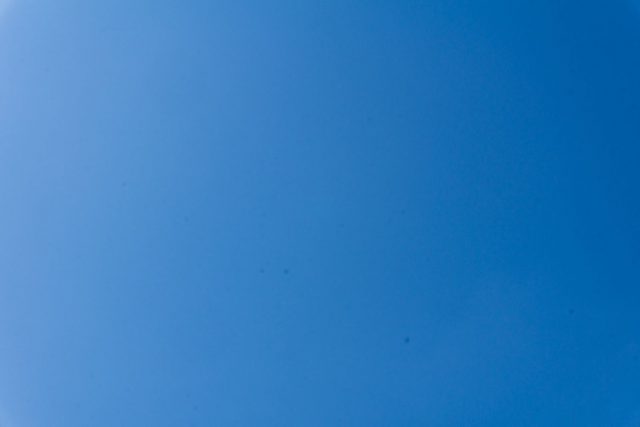I was reviewing a batch of my photos recently, and to my horror, I spotted some shadows. Okay, “horror” might be an exaggeration, but those shadows certainly caused some anxiety. There was dust somewhere in my camera. Either on the sensor, or on the rear element of my lens.
A quick check on the Internet told me that the shadows I had were characteristic of sensor dust. I took some test shots of a bright blue sky to confirm. Fortunately it was a clear day that day with few clouds. Perfect for shooting a test shot with minimum aperture (largest f number).
Dust on sensor shows up as relatively clear distinct shadows on the test shot. You can find quite a number in the sample photo above. It helps to push the contrast to maximum when you review the downloaded test shot, so that the shadow stands out more clearly.
Dust on the rear lens element tends to produce shadows with more fuzzy edges. The sample you see above is quite clearly dust on the sensor. Knowing where the dust is, of course, is just the beginning.
Once you know where the dust is on your photo image, the next step is to find it on the camera sensor. Basically, things are simply inverted, both laterally and vertically on the sensor from where it is in the photo image. For example, if you see a shadow spot in the top left corner of your photo image, then the dust is located on the bottom right corner of the sensor as you look toward the sensor through the lens mount.
In my case, I simply couldn’t see the dust. It must have been really minuscule, or my eyesight is getting pretty bad. I tried to blow the dust away with an air blower, you know those rubber thingy that you squeeze to eject out a puff of air. After what I thought was a pretty thorough blow-clean, I took a test shot to check the result. The shadowy spots where still there.
I think it took me about the fourth attempt before I finally got an all-clear in my test shot. The last bit of dust that finally came out must have been really stubborn.
So I’ve been advised about a couple of things, all of them pretty much gels up with what I read on the Internet, but of course better confirmed with recommendations from friends.
- Get a sensor loupe. It will help see the sensor a whole lot more clearly. Something like this Lenspen SensorKlear Loupe Kit is pretty handy. It seems costly though, compared to options like this Carson loupe. I’ll leave it to you to do your own research.
- Apart from using a good air blower, a nice tool to have is this sensor gel stick. The gel picks up dust from the sensor, then you transfer to some sticky paper, so you can use the sensor gel stick again to pick up more dust. It sounds a lot safer than brushes and other wet cleaning methods.
I’m somewhat less confident about using wet cleaning methods since it involves so much more contact with the camera sensor. For now, I’m more inclined to go with safer cleaning methods.

View Comment Policy